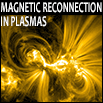Speaker
Dr
Stefano Markidis
(KTH)
Description
We present the first 3D global simulation of Ganymede’s
magnetosphere in a unified framework coupling the fluid and kinetic
models. An MHD model describes the global interaction of solar wind
with Ganymede’s magnetosphere over the whole simulation domain. A
kinetic model is used only in the selected space regions, where kinetic
effects dominate and MHD description fails. In particular, kinetic
regions are used in Ganymede magnetotail and dayside magnetopause
to correctly describe magnetic reconnection in these regions. This is the
first simulation capable of combining fluid and kinetic approaches in a
realistic large-scale simulation of a planet’s magnetosphere.
In this work, the BATS-R-US MHD code is coupled with the iPIC3D
Particle-in-Cell kinetic code. The coupling is two-way as both the MHD
and kinetic codes provide reciprocal feedback. The electromagnetic
fields of the fluid region are used as the boundary conditions for the
electromagnetic fields in the kinetic regions; the fluid pressure tensor is
used to sample distribution functions at the boundary of the kinetic
regions. On the other hand, the kinetic areas provide the fluid regions
the correct electromagnetic field values calculated with the kinetic
approach. The coupling of the two codes has been realized within the
SWMF framework, a highly scalable parallel environment for space
weather modeling. The software coupling is achieved by using message
passing among different BATS-R-US and iPIC3D instances that can run
on different computational resources.
In this talk, we present the coupling strategy that enabled the first
global fluid-kinetic simulation of Ganymede’s magnetosphere and the
simulation results of the solar wind interaction with Ganymede’s
magnetosphere focusing on the kinetic magnetic reconnection in
magnetotail and in dayside magnetopause. Finally, we discuss the
impact and application of this work to other planetary magnetosphere.
Primary author
Dr
Stefano Markidis
(KTH)
Co-author
Ivy Bo Peng
(KTH)

